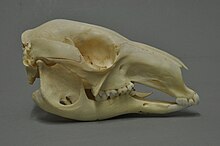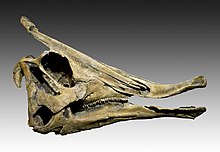Diastema (zoology)
Diastema (from ancient Greek διάστημα diástēma "space") or diastema is called in zoology an evolutionarily acquired, consequently non-pathological, more or less wide gap in the row of teeth of mammals and other amniotes with strongly differentiated teeth . Diastemas occur in numerous recent and extinct species of amniotes in different positions in the dentition. As a rule, diastemas occur in the area of the canine or in the area between the rearmost incisor and the foremost molar. Particularly pronounced diastemas are found in representatives of amniote groups who specialize in hard-fiber vegetable foods, including ungulates .
Primates

The primate diastem is the relatively small space between the canine and incisor in the upper jaw and the even smaller space between the canine and the first premolar in the lower jaw. This diastem is also known as the monkey gap or primate gap . It occurs in both Hunds- as well as apes and has the function to provide the opposite row of teeth when the mouth is closed space for the tips of the relatively large, sometimes very strongly developed especially for male canines. In modern humans ( Homo sapiens ) there is no monkey gap, the row of teeth is closed and the canines are no larger than the incisors. In the case of fossil pines from early humans, the presence or absence of the ape gap is an indication of whether the corresponding specimen can be assigned to a more ape-like, “primitive” or a more human-like, “progressive” form. In some australopithecines, the ape gap is completely reduced.
Ungulates

In ungulates there is a relatively wide diastem between the outer (rear) incisors and the front molars (usually the premolars). The canine teeth are completely reduced in many ungulates. In numerous cloven-hoofed lines , especially those belonging to the ruminant group , the upper incisors are also completely reduced, so that there is no diastem in the actual sense of the word in the upper jaw because the dentition only begins with the premolars. In the heavily modified skull and dentition of the elephant , a real diastema only occurs in the upper jaw because the lower jaw has no incisors.
The function of the diastem in ungulates is not exactly understood. Among other things, a greater freedom of movement of the tongue when passing on food from the incisors to the molars or generally when manipulating the food in the oral cavity is stated. Another explanation suggests that the diastem is more an expression of the decreasing leverage with increasing length of the lever arm: Because molars cause relatively high metabolic costs, a grinding surface that extends to the incisors would be uneconomical for long skulls or jaws. A diastem would simply be the by-product of a long skull.
Rodents and lagomorphs

Even rodents and lagomorphs have a markedly distinctive Diastem between the bicuspids and incisors at reduced canine, wherein said rodents have only an incisor per jaw, but is formed stronger than the two front teeth of the lagomorphs.
The presence of the diastem in rodents is closely related to the evolving of the large "rootless" incisors ("incisors"), which reach deep into the bone, leaving no space for the roots of other teeth in the front part of the jaw. In addition, the diastem ensures a functional decoupling of the incisor teeth from the molars: When the incisor teeth are used, the lower jaw is pushed forward and the molars of the lower jaw are then opposite the diastem in the upper jaw. This protects them from unnecessary wear and tear while the animal is moving its jaws. In addition, rodents with their deeply split upper lip can close the oral cavity behind them when their incisor teeth are in use (e.g. beavers are cutting trees for dam construction), so that the incisor teeth are actually outside the functional oral cavity.
Marsupials

Some representatives of the marsupial group Diprotodontia who specialize in hard fiber plant food, including the kangaroos , have a sometimes very wide diastem between the incisors and the molars with a reduction in the canines. The cause and function of the diastema are likely to be similar to those in placental mammals . Since marsupials with diastema and placental mammals with diastema have different common ancestors without diastema, the developments are convergent .
dinosaur

A similar development in the morphology of the teeth took place outside of mammals in the bird basin dinosaurs , especially in the ceratopsians and the ornithopods . The representatives of these groups are likely to have had a diet similar to that of ungulates and have chewed their food extensively. In both ceratopsians and ornithopods, the front teeth were completely replaced by a sharp horned beak, and the individually rather small teeth in the rear area of the jaw formed so-called tooth batteries, which were very similar in function to the molars of mammals. These representatives describe the toothless area between the hornbill and the dental battery as the diastem.
See also
Individual evidence
- ^ Wilhelm Gemoll: Greek-German school and hand dictionary. Munich · Vienna 1965.
- ↑ Erich Thenius: Evolution of life - and man. The geological documentation. Lecture, Vienna 1980 ( PDF )
- ↑ Cristine M. Janis: Correlations between craniodental morphology and feeding behavior in ungulates: reciprocal illumination between living and fossil taxa. In: Jeff J. Thomason (Ed.): Functional Morphology in Vertebrate Paleontology. Cambridge University Press, Cambridge UK New York Melbourne 1995, ISBN 0-521-44095-5 , pp. 76-98
- ^ Walter S. Greaves: Functional predictions from theoretical models of the skull and jaws in reptiles and mammals. In: Jeff J. Thomason (Ed.): Functional Morphology in Vertebrate Paleontology. Cambridge University Press, Cambridge UK New York Melbourne 1995, ISBN 0-521-44095-5 , pp. 99-135
- ↑ Stuart O. Landry, Jr .: The Rodentia as Omnivores. The Quarterly Review of Biology. Vol. 45, No. 4, 1970, pp. 351-372 ( JSTOR 2821009 )
- ↑ David E. Fastovsky, Joshua B. Smith: Dinosaur Paleoecology. In: David B. Weishampel, Peter Dodson, Halszka Osmólska (eds.): The Dinosauria . Second edition. University of California Press, Berkeley 2004, pp. 614-626, ISBN 0-520-24209-2